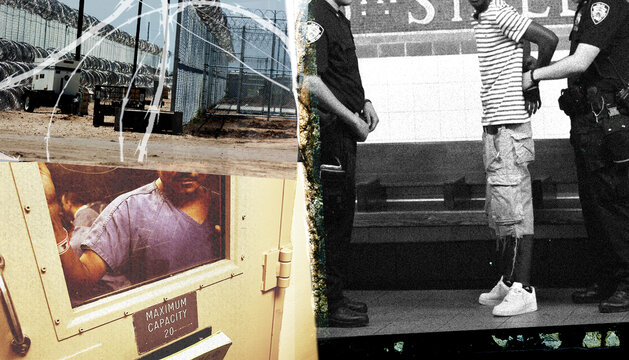
Addressing Violent Crime More Effectively
Excessive punishment is the wrong response to rises in homicide rates.

Part of
This essay is part of the Brennan Center’s series examining the punitive excess that has come to define America’s criminal legal system.
Over the past year and a half, as the United States struggled to address Covid-19, homicides in major American cities have increased sharply, and aggravated assaults appear to have increased, too. The numbers have been frightening: a 30 percent jump in killings in 2020, and a further increase of 16 percent in the first half of 2021. Over an 18-month period, about 33,000 lives were lost to violence in the United States — 8,400 more than would have been killed had homicide rates stayed the same as in 2019.
These numbers pale, of course, beside the more than 600,000 American deaths from the coronavirus over the same period. It’s also true that homicide rates across the United States have stayed far below their peaks in the 1980s and early 1990s, and about the same as what they were in the early 2000s. Still, 8,400 killings — let alone 33,000 killings — is a staggering toll. The numbers are even more devastating for Black Americans and Latinos, who are disproportionately the victims of lethal violence in the United States. For Black men under 45, homicide is far and away the leading cause of death, accounting for nearly a third of all fatalities; for Latino men in the same age group, it is the second leading cause of death.
So, while it’s good that the recent spike in homicides is getting attention, it’s critical not to respond with the kinds of policies that gave us mass incarceration and are helping to perpetuate it — in particular, the aggressive use of decades-long, mandatory prison sentences for “violent” crimes. There are better ways to respond: approaches that have proven effective in reducing extreme violence, without driving prison populations even higher.
For the last half-century, America’s chief strategy for attacking violent crime has been to double down on punishment. About half of all people behind bars in the United States are serving time for offenses classified as violent, many of them with mandatory terms prescribed by “three strikes” laws adopted in the 1990s. A third of all California prisoners, for example, were sentenced under the state’s three strikes law.
These laws are part of a web of punitive policies aimed at violent offenders, who also are commonly excluded from diversion programs, problem-solving courts, eligibility for early parole or humanitarian release, opportunities to expunge or seal convictions, and laws allowing re-enfranchisement. In Oklahoma, for example, defendants charged with violent crimes cannot be diverted to drug courts or mental health courts. If they are convicted and sent to prison, they can be paroled only by special order of the governor, and they generally are ineligible to use the state’s expungement statute.
People charged with violent crimes are also often denied procedural protections provided to other defendants. For example, in Nevada the evidentiary privileges for spouses cannot be invoked by defendants accused of violent offenses. Even before the pandemic, violent crime was something of a third rail for criminal justice reform in the United States, despite the clear, mathematical fact that there is no way to seriously address mass incarceration without radically reducing penalties for violent offenders.
There are three things wrong with these “brute force” responses to violent crime. The first is that they impose massive harm for negligible benefit. There’s no evidence that draconian sentences have done much to reduce violence in the United States. They keep offenders locked up long after they represent any significant threat, and they don’t appreciably increase deterrence, which depends more on the certainty of punishment than on its severity. It’s true that crime plummeted in the 1990s, when imprisonment rates were rising, but imprisonment rates also rose during the 1970s and 1980s, without any change in crime rates. And crime rates during the 1990s — particularly rates of serious violence offenses — dropped just as dramatically in Canada as in the United States, and there was no mass incarceration north of the border. Decades of research have failed to show any beneficial effect of our long prison sentences on public safety. What is certain is that they destroy lives, tear apart families, hollow out communities, and wreck state budgets.
The second problem, which exacerbates the first, is that “violence” is a morally freighted term without clear boundaries. Calling a crime “violent” is a way of placing it beyond the pale, outside the proper sphere of mercy, redemption, or understanding. Legal definitions of “violent crime” are highly arbitrary, reflecting the vagaries of moral condemnation rather than efforts at descriptive accuracy. Burglary is widely classified as violent, for example, even if no one is hurt or even at home when the crime occurs. Arkansas and Rhode Island even treat larceny as a violent offense. Bodily assaults, on the other hand, generally trigger the special penalties for violent crimes only when they are “aggravated” by the infliction of “serious” injury or the involvement of a “deadly” weapon, factors that typically reflect the subjective judgment of police and prosecutors. Whether a crime qualifies as “violent” can also be heavily influenced by racial bias and other forms of prejudice.
The third and final problem with America’s heightened penalties for violent crime is that they treat violence as overwhelmingly a matter of character rather than of circumstances. It takes remarkably few episodes of violence for someone to be labeled a “career” or “habitual” offender — three “strikes,” or in many places only two. In California, for example, a single previous conviction for a “serious or violent felony” doubles the required prison term for a subsequent offense. In many states, similarly, a single conviction for a violent felony, sometimes only a single arrest, can disqualify a defendant from diversion programs. The assumption underlying modern recidivism enhancements, and the eligibility restrictions on diversion programs, isn’t that a small subset of murders, rapes, and aggravated assaults are carried out by people who commit violent offenses again and again; it’s that anyone who commits two or three violent crimes is likely to be inherently violent. Our laws increasingly assume that the roots of violence are in the hearts and minds of offenders, not in the situations in which they find themselves. We tend to neglect the powerful social drivers of violence: from poverty and racism to the wide availability of guns in the United States.
Covid-19 may be in that category, too. It’s not clear exactly why homicides have spiked in the United States during the pandemic. The same thing hasn’t happened in the United Kingdom or elsewhere in Europe, and there are cities in the United States that have bucked the trend as well. Some of the nationwide increase in killings over the past 18 months may have to do with the disruption of social services, which were already thinner here than across the Atlantic. Some may be due to a surge of gun purchases during the pandemic. Some may be traceable to the erosion of trust between the police and public following the murder of George Floyd in May 2020. (One factor that can be ruled out, though, is the adoption of more lenient criminal justice policies, including the early release of some prisoners, in liberal parts of the country. Killings have risen in all parts of the country, just as much in Republican-led cities as in cities with Democratic mayors, and just as much in counties with and without progressive prosecutors.) There’s good reason to think, though, that bringing the coronavirus under control should be part of any strategy to confront the rising homicide rate. And, in fact, as the worst days of the pandemic have receded in New York City, homicides have fallen as well.
But if Covid-19 has in fact increased homicides, simplistic generalizations about “violent crime” have in turn worsened the public health emergency. It was clear from early 2020 that overcrowded prisons and jails would help the virus spread rapidly. But government officials across the country, Democrats as well as Republicans, have repeatedly balked at releasing “violent” offenders from prisons and jails, even as the death toll from the virus in carceral institutions has surpassed 2,700, and even as the definition of “violent” remains vague and contingent.
Plainly, though, tackling Covid-19 can’t be the beginning and end of our anti-homicide strategy. Even before the pandemic, far too many people were dying violently in the United States. Fortunately, there is growing evidence that gun homicides between non-intimates — the kind of killings that have risen sharply over the past year and a half — can be reduced dramatically by violence reduction programs concentrated on the relatively small number of people, places, and social interactions responsible for most of the street violence in a given city. These programs are not easy to carry out successfully, and they are even more difficult to sustain over the long term. Pairing focused deterrence with social services and peer-to-peer counseling, they require trust and collaboration between police and community groups, close analysis of local patterns of violence, restraint on the part of police and prosecutors, a strong commitment to helping individuals exit cycles of violence, and an institutional framework that can survive leadership changes, budget crises, and the inevitable calls for tougher approaches when, as in 2020 and 2021, homicide rates begin to climb.
The most famous of these programs, and a model for many of its successors, was Boston’s Ceasefire initiative, which dramatically reduced youth homicides by interrupting cycles of retaliatory gang violence. Ceasefire identified a relatively small number of groups responsible for the bulk of youth shootings in Boston and targeted their members with threats of criminal enforcement along with offers of economic support and social services if they refrained from gun violence. The program relied on consultation and coordination between the police department, a range of other municipal agencies and nonprofit groups, and inner-city clergy. A more recent, successful version of the Ceasefire approach, in Oakland, California, has focused on adult shooters rather than juveniles (reflecting differences between homicide patterns in Oakland and Boston) and has deemphasized the role of the police while expanding the role of peer-to-peer counseling.
It often takes several tries, stretching over years, before a city finds the right approach, appropriately tailored to local circumstances. And even the most successful programs, like those in Boston and Oakland, are not panaceas: both cities have seen increases in gun violence during the pandemic.
Still, we know these programs can work. Boston’s reduced youth homicides by roughly 50 percent. Those gains began to disappear in the early 2000s when the program was discontinued, then were recovered when the program was restarted. The results in Oakland were similarly impressive: both homicides and nonfatal shootings were cut in half. We also know that there are ways to reduce violent encounters between the police and the public, and ways to curtail prison violence, and ways to help victims of abuse within families and intimate relationships protect themselves from getting killed.
None of this is easy. Simpler and emotionally cathartic responses, like longer prison sentences for people convicted of violent crimes, have an obvious allure. But we have been down that road before. It leads nowhere good. Violence is a hard problem, and it cannot be ignored or simply wished away. But even the most pressing of crises can be made worse.
David Alan Sklansky is the Stanley Morrison Professor of Law and a faculty co-director of the Stanford Criminal Justice Center at Stanford Law School.
More from the Punitive Excess series
-
End Mandatory Minimums
Inflexible, harsh sentences exacerbate crime and racial disparities alike. -
Independent Oversight Is Essential for a Safe and Healthy Prison System
Preventive monitoring of conditions in American prisons can help shine a light on what needs to change. -
There Is No One Answer to Over-Policing and Mass Incarceration — There Are Many
Examples abound for successful alternative methods that can greatly improve the current criminal legal system.



